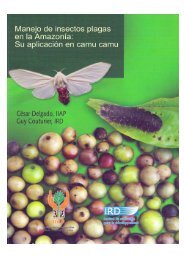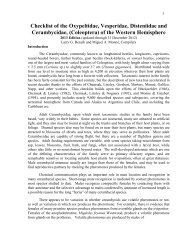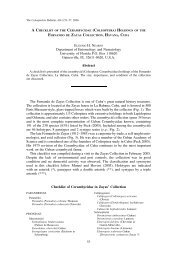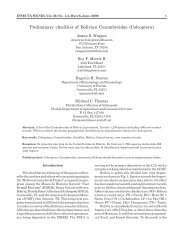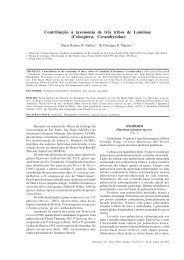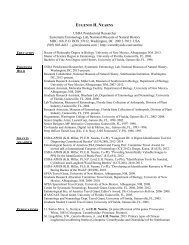You also want an ePaper? Increase the reach of your titles
YUMPU automatically turns print PDFs into web optimized ePapers that Google loves.
INTRODuc'rION<br />
As known at present, the tribe Onciderini includes about 250<br />
species, all of which are confined to the New ·World. Of these<br />
only six species occur north of Mexico.<br />
Elongate, ovate or oblong, usualiy robust, cylindrical or otherwise, filllaU to<br />
moderately large in size, ranging from 6 to ncar ly 30 mm. in length. Head at<br />
base about as wide as protborax, not retractile, transverse when viewed from above;<br />
front elongate to slightly transverse, variable in shape, narrowed above or below<br />
(or both) or with sides parallel, flat (rarely convex) when viewed from sides,<br />
parallel w anterior margin of prothorax; eyes deeply emarginatc, sometimes nearly<br />
divided, lower lobe variable in size, usually elongate; antcIlDnJ tubercles prominent,<br />
more or less robust, often n.rmed at apex in male; antennae usually longer in male<br />
than in female, fringed beneath on proximal segments, sometimes densely so; scape<br />
at least attaining apical margin of pronotum, variable in form, without an apical<br />
cic.'l.trix (except in Cicatrodea). Pronotum at least slightly transverse, usually<br />
strongly so; at sides often with a tubere1e placed slightly behind middle. Elytr:l<br />
. usually with humeri prominent, sometimes strongly projecting; elytral apices<br />
rounded together or sep.'\fately (in Ecthoea bident.:l.te); hind w i ngs always present.<br />
Procoxal cavities always closed behind, angulate externtllly; mesocoxal envities<br />
angulated :lIld open externally. Legs variable from short to moderately long;<br />
procoxae large, globose, re:lching nearly to apex and base of prothorax, often armed<br />
in male; femora robust, clavate apically; mesotibi:le sulcate externally, met.'l.tibiae<br />
often strongly dilated apically in male; tarsi nearly as long as tibiae, first three<br />
segments subequnl in length, about as long as broad, first rarely slightly elongate,<br />
claw segment nearly as long as first three together; claws divergent, simple.<br />
Abdomen with first strenite elongate, nearly as long or longer than second and<br />
third together, fifth longer than fourth.<br />
In the Onocephalini which are closely related to the present<br />
tribe, the form of the antennal scape is slender, cylindrical j the<br />
front is slightly convex and is ore strongly inclined tl1un apical<br />
margin of prothorax, and the femora are only feebly clavate, rather<br />
slender. The Hippopsini, including Pachypeza, have the legs very<br />
short, the bead above and the pronotum elongate j the antennal<br />
tubercles are more prominent j and the procoxae are much smaller,<br />
not nearly attaining anterior margin of protbOI'RX.<br />
MORPHOLOGTCAL FEATURES<br />
Most of the critical morphological characters are very variable<br />
within the tribe, DO single cbaracter being dependable in the sepa<br />
ration of the genera. However, the sLape of the pronotum enables<br />
(v)



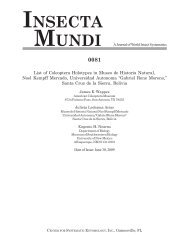
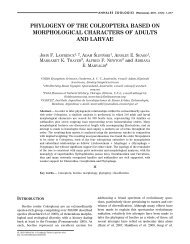


![Coleoptera. Vol. I. [Longicornia. Part I.]](https://img.yumpu.com/41202793/1/180x260/coleoptera-vol-i-longicornia-part-i.jpg?quality=85)
